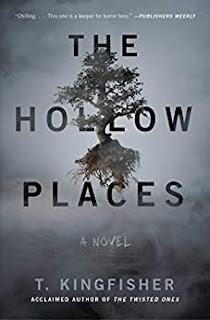Nettle and Bone, by T.
Kingfisher. Tor, 2022

I
found Kingfisher’s latest delightful. Written in the style of fairy
tales, it is set in a
fantasy world where magic of different sorts works. Our heroine,
Marra, is the third child of the king and queen of a tiny realm that
includes a deep water harbor, a valuable asset. The
powerful kingdoms to their north and south both want to control the
harbor, and the queen knows what must be done. The oldest daughter,
the beautiful and sweet Damia, is wed to the northern prince, with
the understanding that their oldest child would rule the north, while
the second would rule the harbor kingdom. It’s no time before Damia
dies, however, and the middle daughter, Kania, less beautiful and
much less sweet, is carried off to be the prince’s next wife and
broodmare. At 15, Marra is bundled off to a nunnery to live,
hopefully safe and forgotten by the world. Here she lives for 15
years, shoveling animal stalls, working in the kitchen, delivering
babies, and spending vast
amounts of time learning needlework. Little
news gets there, but finally there is a funeral to be held in the
northern kingdom; the girl child of Kania and prince Vorling has
died. Taken from the nunnery to attend, Marra finds that things are
not well in her sister’s life. Not only is she nearly constantly
pregnant and failing to produce a viable child, much less a prince,
but Marra sees bruises on her sister, who admits they were put there-
frequently- by Vorling. This, Marra decides, can not be allowed to go
on. Here starts her quest
for justice.
Since
she is not a nun, but just living there, the abbess cannot stop Marra
when she leaves. She seeks the help of a dust-wife, who is a powerful
witch who can work with the dead. When Marra tells her what she
wants- to free her sister by killing Vorling- she agrees that she
will help IF Marra can accomplish three tasks: weave a cloak of owl
cloth and nettles, create a living dog from a pit full of bones, and
catch the moonlight in a jar. Marra manages the first two, and they
are off on their quest. Along
the way they gather helpers; a magical
godmother, an ex-knight
who is held slave in a goblin market, a hen possessed by a demon (but
the best layer of the flock), a cursed chick who
finds things, an inn keeper with a demonic parasite. The
odds are against them, and they have no firm plan, but try they
will….
The
characters are wonderful. There is no Chosen One, and no one has a
gods given Purpose. These are the people who are frequently over
looked in stories. Their adventures are fantastical and, at times,
absurd. There is a hint of Pratchett in this world, but with few puns
and a much more believable set up. This book was a couldn’t-
put-it-down one for me. The world is not a pretty, high fantasy one,
but a world you could believe once existed on earth. Five shiny
stars!





















